
David Kuperman presented “King Street transit pilot strategies to improve surface transit performance in the City of Toronto” at the UT-ITE seminar on September 28, 2018.
King Street is a major east-west arterial that crosses the Financial and Entertainment districts of downtown Toronto. It is the busiest surface transit route in the City of Toronto, and suffered from slow speed as well as unreliable and overcrowded streetcars. The King Street transit pilot was proposed to improve transit reliability, speed, and capacity by giving priority to streetcars over private vehicles.
The King Street pilot was implemented in November 2017, and included changes to design and operations. The changes introduced were based on feedback and collected data. One example is the decision to ban private vehicles from proceeding through intersections.
The project embraced modern monitoring techniques, such as streetcar GPS tracking, permanent video-based counting, and Bluetooth readers for data gathering.
The King Street pilot has resulted in about five minutes’ improvement to transit travel times, as well as significant increases in reliability and capacity of streetcars. Notably, these improvements have not have a negative effect on other parallel and intersecting corridors. Changes to signal timing, based on the gathered data, improved flow at the key intersections. Moreover, the King Street pilot project has led to public realm improvements such as the opening of new public spaces.
These are just a few points regarding David Kuperman’s talk on the King Street transit pilot. For more information, please view the presentation slides provided by David Kuperman and/or watch a video of his presentation by clicking on the image below:
Abstract
Downtown population and employment growth in Toronto have led to daily ridership on the King Street streetcar, which operates in mixed traffic, being higher than on any other surface transit route. Various operational improvements were applied to the route by both the City and the Toronto Transit Commission from 2014 to 2016, including extended peak period traffic restrictions, transit signal priority, stop consolidation, all-door boarding, and a new larger capacity streetcar fleet in delivery. Continued low travel speeds and low reliability required that further interventions be considered.
A pilot project study was undertaken by the City of Toronto and the TTC, in consultation with key stakeholders, to collect data and develop and test a new solution to prioritize transit on King Street. New traffic counts were undertaken, along with curbside activity surveys, new ridership counts, and travel time and delay surveys. The resulting design concept was a transit priority corridor that would allow local traffic and access to destinations on King Street, but restrict through traffic by prohibiting through movements at the majority of intersections in the pilot area, a 2.6-kilometre long section of the street through the downtown core, including entertainment and financial districts. Local traffic would share the median lane with streetcars, while the curb lane would be repurposed for far-side streetcar stop platforms, commercial and passenger loading zones, right-turn storage, and public spaces.
The King Street Transit Pilot launched in November 2017, is proceeding through the end of 2018, and includes changes to the design and operations throughout the course of the project, based on feedback and collected data. There is a comprehensive evaluation and monitoring program in place, in order to measure the speed, capacity, and reliability of transit, as well as multimodal traffic counts and travel times, area sales, and other measures. The project has benefited from the installation of new Bluetooth sensors and cameras for counts via video analytics, and summary data are being posted to the project website on a monthly basis.
Results to date have included improvements to transit travel times of approximately five minutes at the 90th percentile, as well as to reliability and capacity. Increases to travel times on parallel and intersecting corridors have not been found to be significant. Changes to signal timing have been undertaken to improve flow at key intersections in the project area, based on data gathered over the first several months. Additionally, the public realm is being improved with the activation of new public spaces on the street.
Prior to the King Street Transit Pilot, the City of Toronto undertook several streetcar delay surveys on key downtown routes, extending peak period traffic restrictions in response to observed delays derived from transit vehicle location data. Currently, the City is also conducting a series of operational corridor studies to collect data on bus route delays and develop operational or transit priority tactics to improve travel times and capacity.
David Kuperman is the Manager of Surface Transit Projects and Acting Manager of Operational Planning and Policy in the Transportation Services Division of the City of Toronto. He is a transportation planner with interests in all modes of transportation, and works together with the Toronto Transit Commission on both localized and strategic initiatives to improve the performance of bus and streetcar routes, as well as on policy initiatives such as curbside management, goods movement, and the high-occupancy vehicle lane network. Major recent initiatives he has led include the modification of traffic regulations to improve streetcar and bus travel times and reliability; the development of a framework for evaluating transit priority measures, which includes impacts to pedestrians and cyclists; and the launch of the King Street Transit Pilot project, which gives streetcars priority by limiting through traffic and providing new loading platforms on a major downtown corridor with the highest surface transit ridership in the city. Also underway are a series of transit corridor studies that will examine opportunities to reduce delay and improve operations on key bus routes.
David has a Bachelor of Science degree from the University of Toronto, and a Master of Science (in Transportation Technology and Policy) from the University of California, Davis.
This seminar is presented by the University of Toronto Institute of Transportation Engineers (ITE) Student Chapter.

